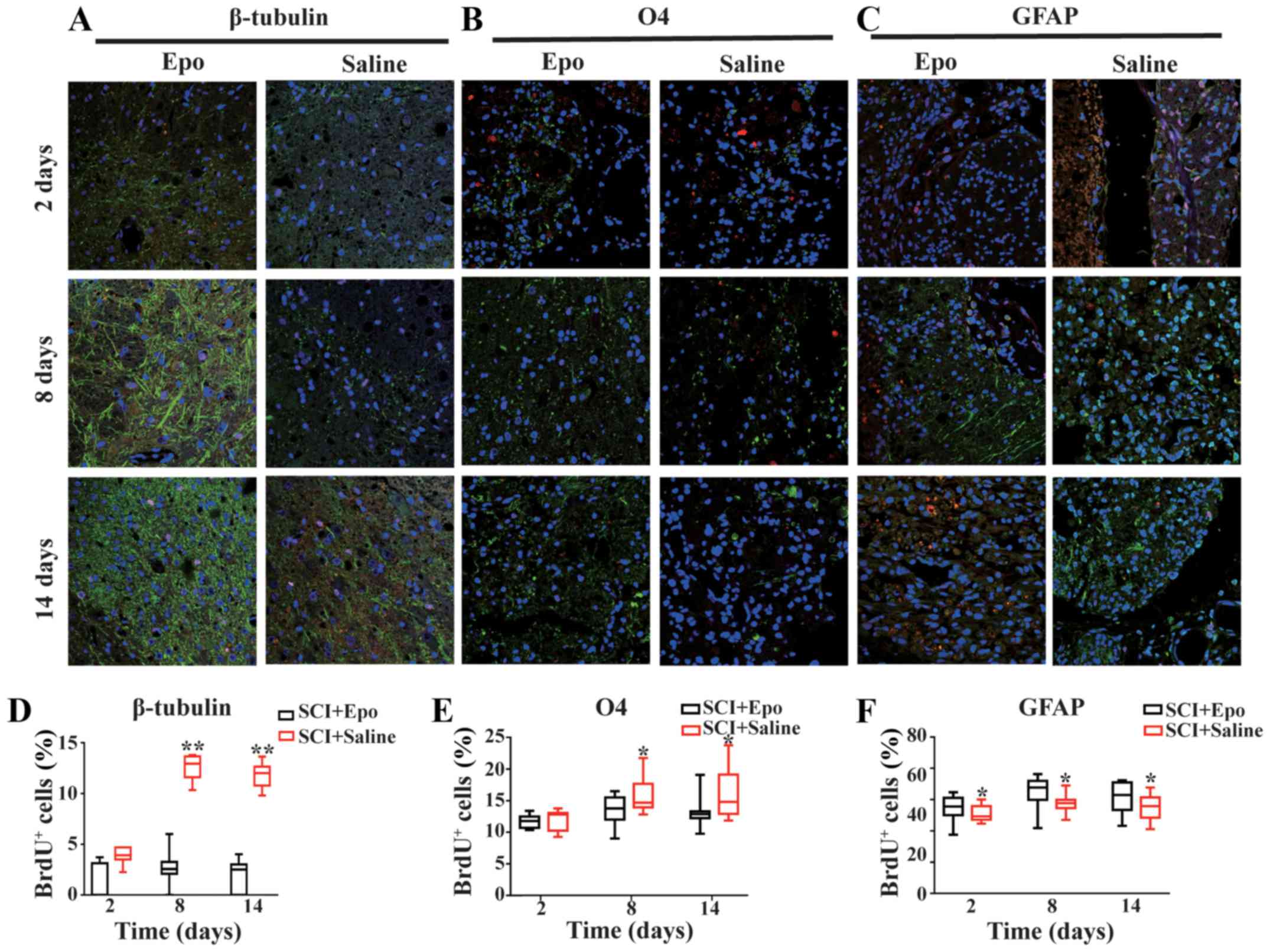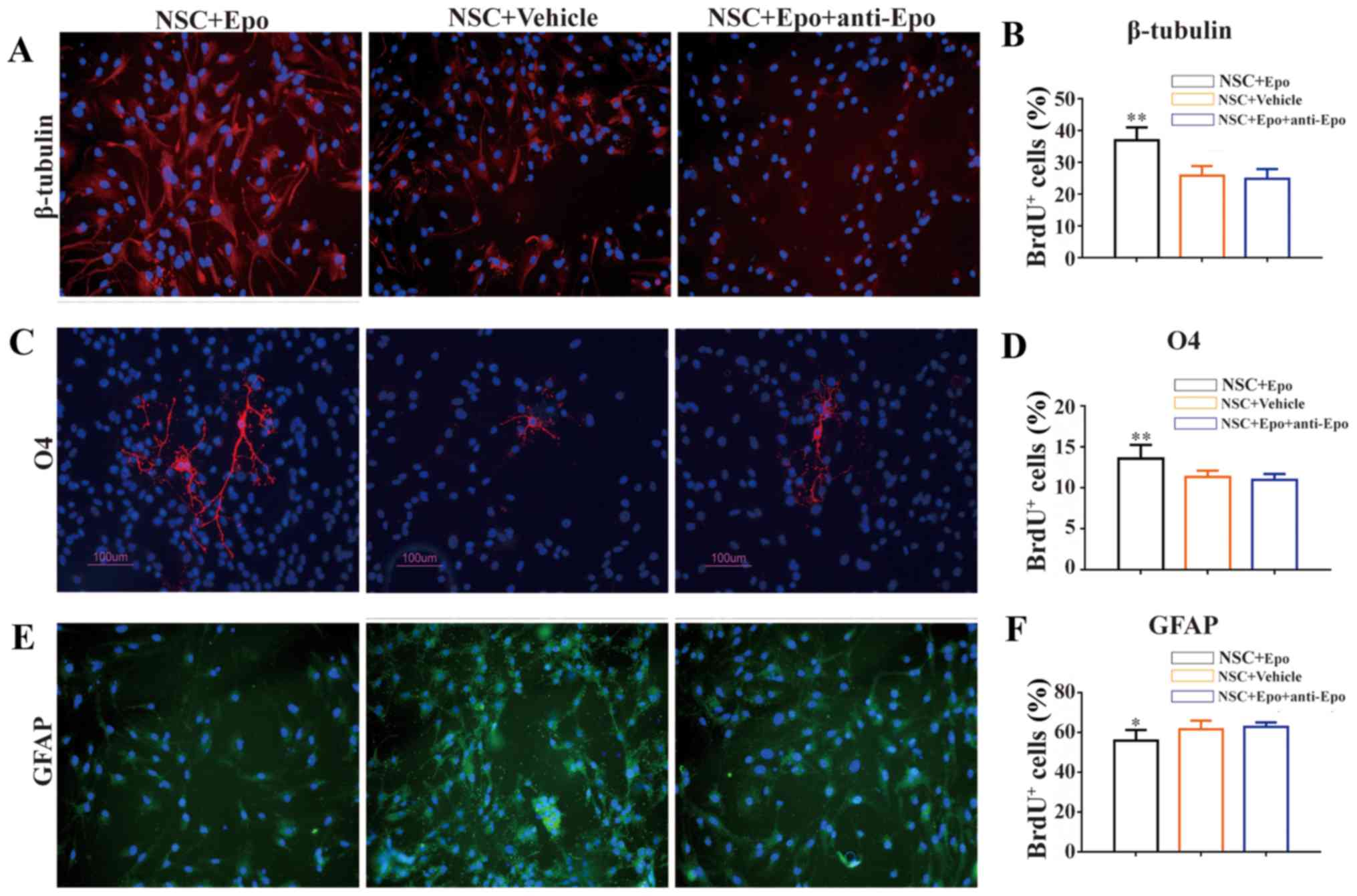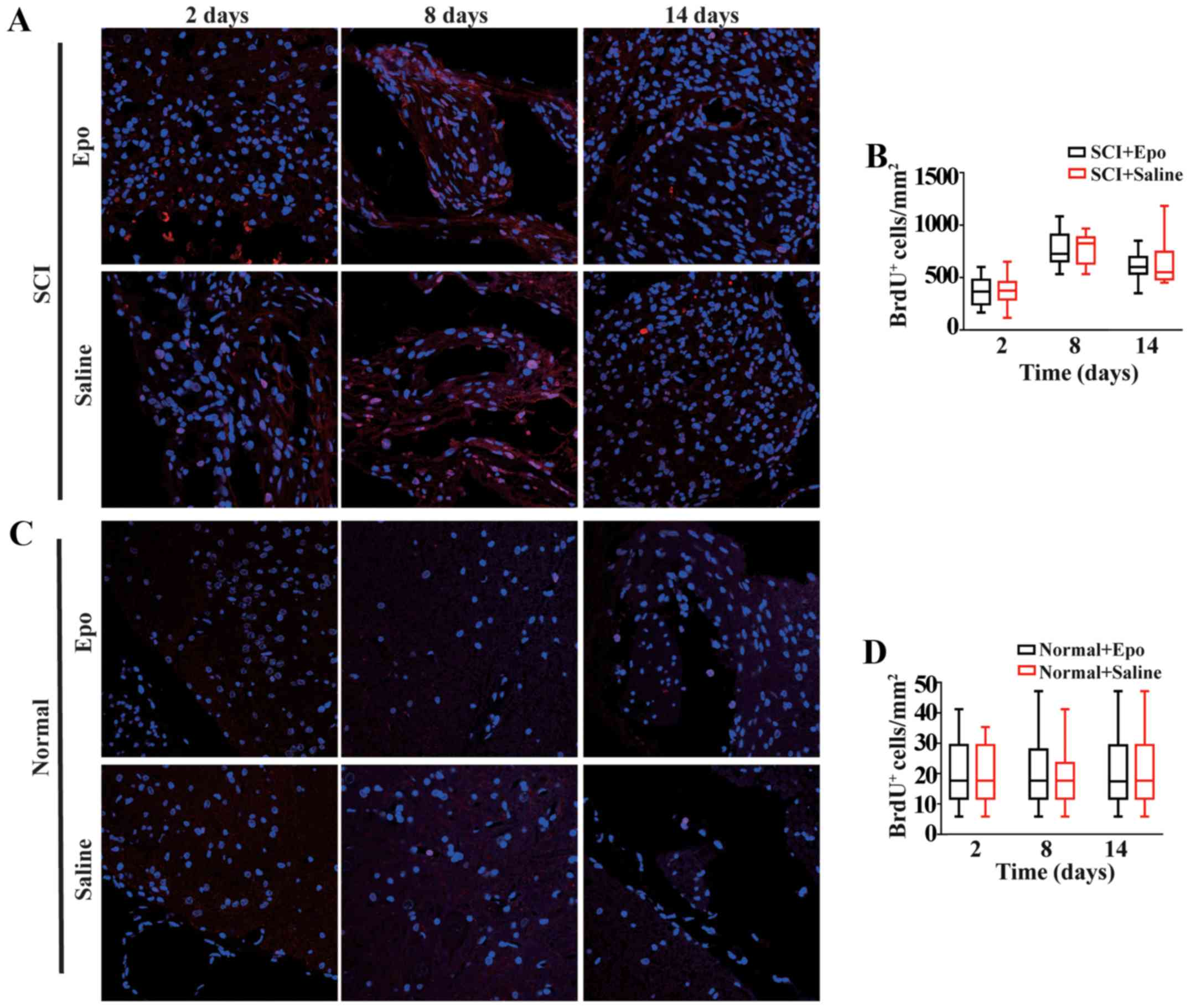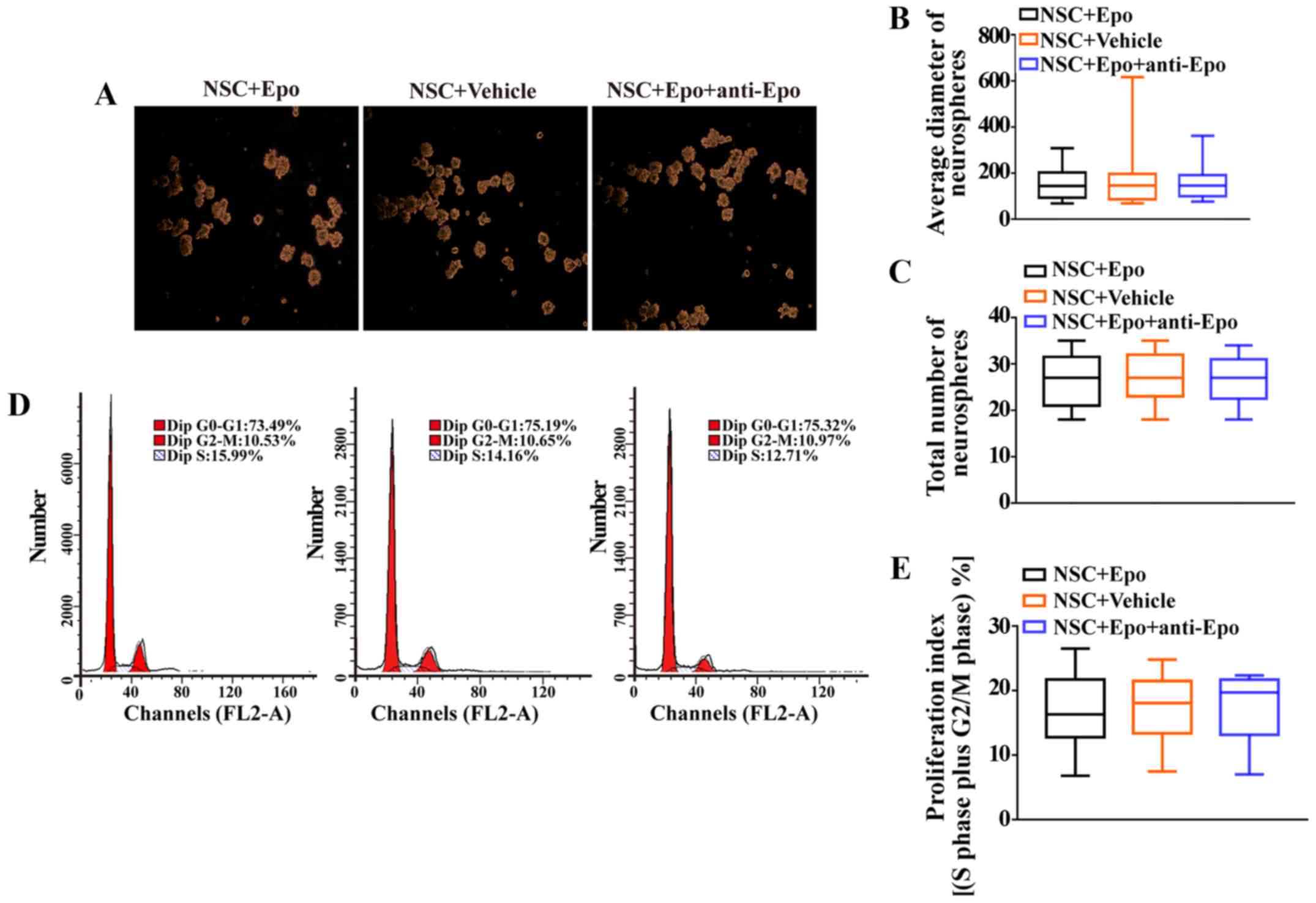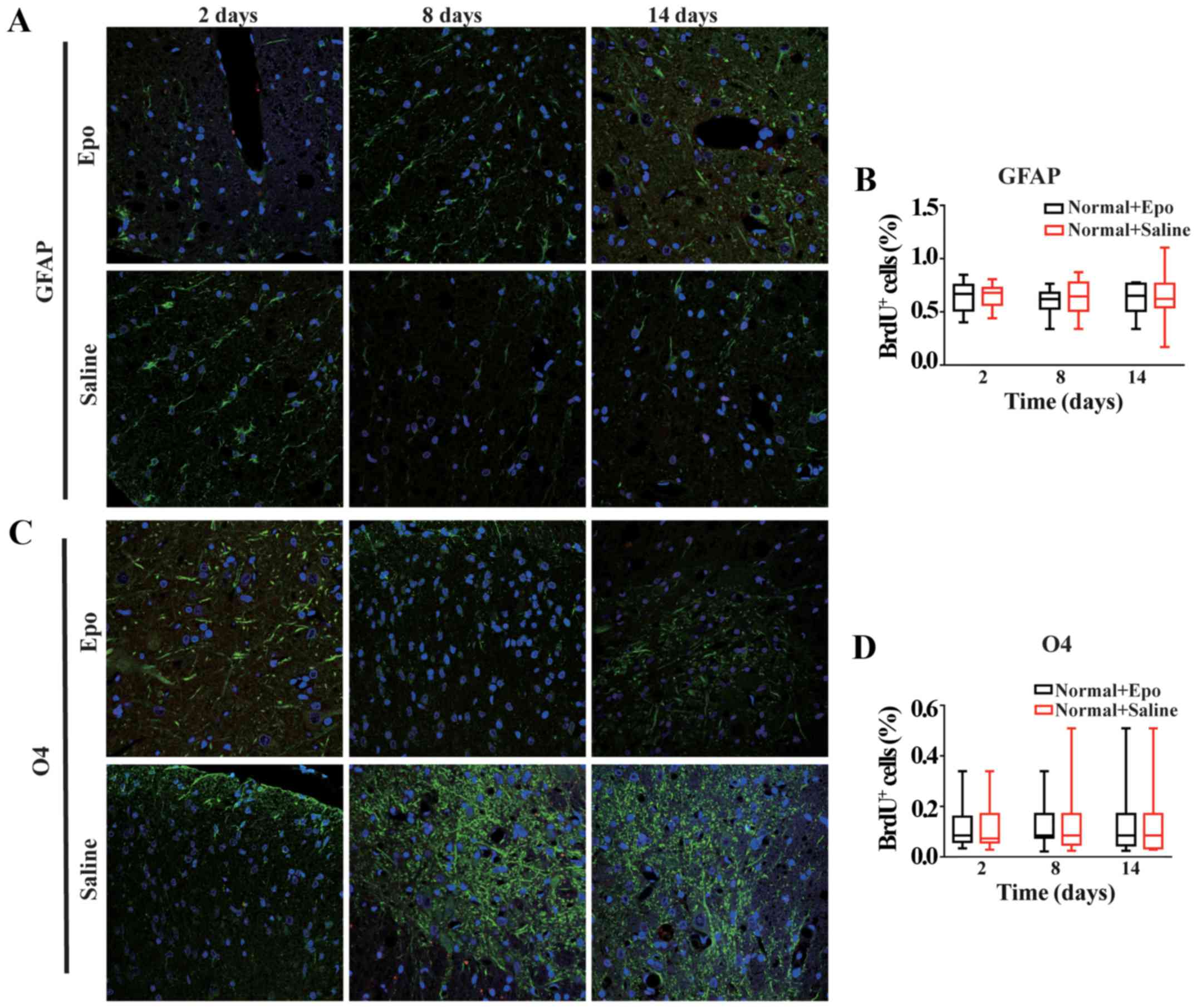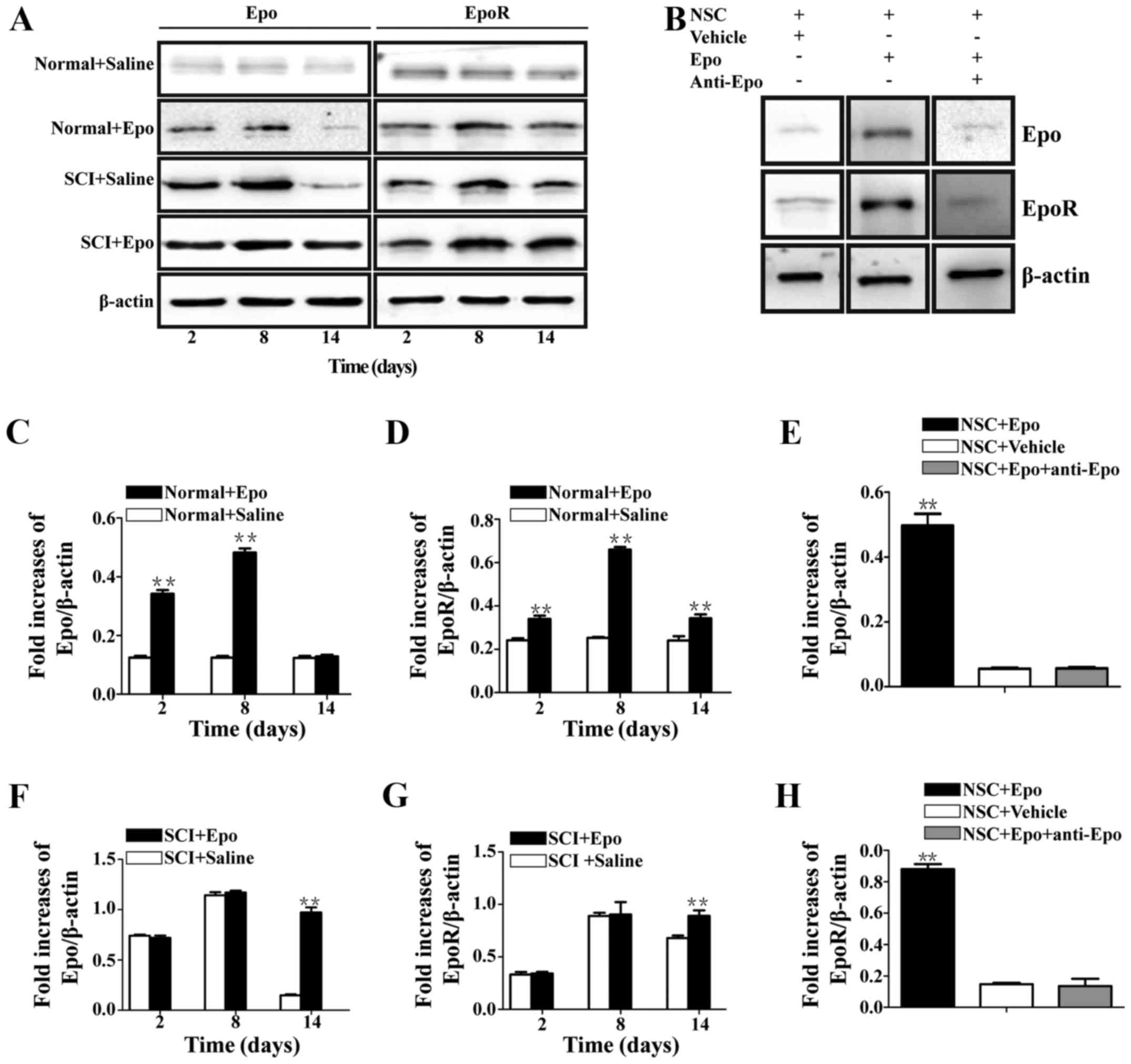|
1
|
Nekoui A and Blaise G: Erythropoietin and
nonhematopoietic effects. Am J Med Sci. 353:76–81. 2017. View Article : Google Scholar : PubMed/NCBI
|
|
2
|
Wu H, Liu X, Jaenisch R and Lodish HF:
Generation of committed erythroid BFU-E and CFU-E progenitors does
not require erythropoietin or the erythropoietin receptor. Cell.
83:59–67. 1995. View Article : Google Scholar : PubMed/NCBI
|
|
3
|
Digicaylioglu M, Bichet S, Marti HH,
Wenger RH, Rivas LA, Bauer C and Gassmann M: Localization of
specific erythropoietin binding sites in defined areas of the mouse
brain. Proc Natl Acad Sci USA. 92:3717–3720. 1995. View Article : Google Scholar : PubMed/NCBI
|
|
4
|
Yu X, Shacka JJ, Eells JB, Suarez-Quian C,
Przygodzki RM, Beleslin-Cokic B, Lin CS, Nikodem VM, Hempstead B,
Flanders KC, et al: Erythropoietin receptor signaling is required
for normal brain development. Development. 129:505–516.
2002.PubMed/NCBI
|
|
5
|
Kaneko N, Kako E and Sawamoto K:
Enhancement of ventricular-subventricular zone-derived neurogenesis
and oligodendrogenesis by erythropoietin and its derivatives. Front
Cell Neurosci. 7:2352013. View Article : Google Scholar : PubMed/NCBI
|
|
6
|
McPherson RJ and Juul SE: Erythropoietin
for infants with hypoxic-ischemic encephalopathy. Curr Opin
Pediatr. 22:139–145. 2010. View Article : Google Scholar : PubMed/NCBI
|
|
7
|
Simon FH, Erhart P, Vcelar B, Scheuerle A,
Schelzig H and Oberhuber A: Erythropoietin preconditioning improves
clinical and histologic outcome in an acute spinal cord ischemia
and reperfusion rabbit model. J Vasc Surg. 64:1797–1804. 2016.
View Article : Google Scholar : PubMed/NCBI
|
|
8
|
Lu D, Mahmood A, Qu C, Goussev A,
Schallert T and Chopp M: Erythropoietin enhances neurogenesis and
restores spatial memory in rats after traumatic brain injury. J
Neurotrauma. 22:1011–1017. 2005. View Article : Google Scholar : PubMed/NCBI
|
|
9
|
Carelli S, Marfia G, Di Giulio AM,
Ghilardi G and Gorio A: Erythropoietin: Recent developments in the
treatment of spinal cord injury. Neurol Res Int. 2011:4531792011.
View Article : Google Scholar : PubMed/NCBI
|
|
10
|
Castaneda-Arellano R, Beas-Zarate C,
Feria-Velasco AI, Bitar-Alatorre EW and Rivera-Cervantes MC: From
neurogenesis to neuroprotection in the epilepsy: Signalling by
erythropoietin. Front Biosci (Landmark Ed). 19:1445–1455. 2014.
View Article : Google Scholar : PubMed/NCBI
|
|
11
|
Simon F, Scheuerle A, Gröger M, Vcelar B,
McCook O, Möller P, Georgieff M, Calzia E, Radermacher P and
Schelzig H: Comparison of carbamylated erythropoietin-FC fusion
protein and recombinant humanerythropoietin during porcine aortic
balloon occlusion-induced spinal cord ischemia/reperfusion injury.
Intensive Care Med. 37:1525–1533. 2011. View Article : Google Scholar : PubMed/NCBI
|
|
12
|
Grégoire CA, Goldenstein BL, Floriddia EM,
Barnabé-Heider F and Fernandes KJ: Endogenous neural stem cell
responses to stroke and spinal cord injury. Glia. 63:1469–1482.
2015. View Article : Google Scholar : PubMed/NCBI
|
|
13
|
Johansson CB, Momma S, Clarke DL, Risling
M, Lendahl U and Frisén J: Identification of a neural stem cell in
the adult mammalian central nervous system. Cell. 96:25–34. 1999.
View Article : Google Scholar : PubMed/NCBI
|
|
14
|
Qin Y, Zhang W and Yang P: Current states
of endogenous stem cells in adult spinal cord. J Neurosci Res.
93:391–398. 2015. View Article : Google Scholar : PubMed/NCBI
|
|
15
|
Vessal M, Aycock A, Garton MT, Ciferri M
and Darian-Smith C: Adult neurogenesis in primate and rodent spinal
cord: comparing a cervical dorsal rhizotomy with a dorsal column
transection. Eur J Neurosci. 26:2777–2794. 2007. View Article : Google Scholar : PubMed/NCBI
|
|
16
|
Yin ZS, Zu B, Chang J and Zhang H: Repair
effect of Wnt3a protein on the contused adult rat spinal cord.
Neurol Res. 30:480–486. 2008. View Article : Google Scholar : PubMed/NCBI
|
|
17
|
Yin ZS, Zhang H, Wang W, Hua XY, Hu Y,
Zhang SQ and Li GW: Wnt-3a protein promote neuronal differentiation
of neural stem cells derived from adult mouse spinal cord. Neurol
Res. 29:847–854. 2007. View Article : Google Scholar : PubMed/NCBI
|
|
18
|
Basso DM, Beattie MS and Bresnahan JC: A
sensitive and reliable locomotor rating scale for open field
testing in rats. J Neurotrauma. 12:1–21. 1995. View Article : Google Scholar : PubMed/NCBI
|
|
19
|
Sharif-Alhoseini M, Khormali M, Rezaei M,
Safdarian M, Hajighadery A, Khalatbari MM, Safdarian M, Meknatkhah
S, Rezvan M, Chalangari M, et al: Animal models of spinal cord
injury: A systematic review. Spinal Cord. 55:714–721. 2017.
View Article : Google Scholar : PubMed/NCBI
|
|
20
|
Zhang J, Li Y, Cui Y, Chen J, Lu M, Elias
SB and Chopp M: Erythropoietin treatment improves neurological
functional recovery in EAE mice. Brain Res. 1034:34–39. 2005.
View Article : Google Scholar : PubMed/NCBI
|
|
21
|
Kaptanoglu E, Solaroglu I, Okutan O,
Surucu HS, Akbiyik F and Beskonakli E: Erythropoietin exerts
neuroprotection after acute spinal cord injury in rats: Effect on
lipid peroxidation and early ultrastructural findings. Neurosurg
Rev. 27:113–120. 2004. View Article : Google Scholar : PubMed/NCBI
|
|
22
|
Ransome MI and Turnley AM: Systemically
delivered Erythropoietin transiently enhances adult hippocampal
neurogenesis. J Neurochem. 102:1953–1965. 2007. View Article : Google Scholar : PubMed/NCBI
|
|
23
|
Hassouna I, Ott C, Wüstefeld L, Offen N,
Neher RA, Mitkovski M, Winkler D, Sperling S, Fries L, Goebbels S,
et al: Revisiting adult neurogenesis and the role of erythropoietin
for neuronal and oligodendroglial differentiation in the
hippocampus. Mol Psychiatry. 21:1752–1767. 2016. View Article : Google Scholar : PubMed/NCBI
|
|
24
|
Shihabuddin LS, Horner PJ, Ray J and Gage
FH: Adult spinal cord stem cells generate neurons after
transplantation in the adult dentate gyrus. J Neurosci.
20:8727–8735. 2000.PubMed/NCBI
|
|
25
|
Brines ML, Ghezzi P, Keenan S, Agnello D,
de Lanerolle NC, Cerami C, Itri LM and Cerami A: Erythropoietin
crosses the blood-brain barrier to protect against experimental
brain injury. Proc Natl Acad Sci USA. 97:10526–10531. 2000.
View Article : Google Scholar : PubMed/NCBI
|
|
26
|
Juul SE, Harcum J, Li Y and Christensen
RD: Erythropoietin is present in the cerebrospinal fluid of
neonates. J Pediatr. 130:428–430. 1997. View Article : Google Scholar : PubMed/NCBI
|
|
27
|
Banks WA, Jumbe NL, Farrell CL, Niehoff ML
and Heatherington AC: Passage of erythropoietic agents across the
blood-brain barrier: a comparison of human and murine
erythropoietin and the analog darbepoetin alfa. Eur J Pharmacol.
505:93–101. 2004. View Article : Google Scholar : PubMed/NCBI
|
|
28
|
Lieutaud T, Andrews PJ, Rhodes JK and
Williamson R: Characterization of the pharmacokinetics of human
recombinant erythropoietin in blood and brain when administered
immediately after lateral fluid percussion brain injury and its
pharmacodynamic effects on IL-1beta and MIP-2 in rats. J
Neurotrauma. 25:1179–1185. 2008. View Article : Google Scholar : PubMed/NCBI
|
|
29
|
Boado RJ, Hui EK, Lu JZ and Pardridge WM:
Drug targeting of erythropoietin across the primate blood-brain
barrier with an IgG molecular Trojan horse. J Pharmacol Exp Ther.
333:961–969. 2010. View Article : Google Scholar : PubMed/NCBI
|
|
30
|
Ehrenreich H, Weissenborn K, Prange H,
Schneider D, Weimar C, Wartenberg K, Schellinger PD, Bohn M, Becker
H, Wegrzyn M, et al: Recombinant human erythropoietin in the
treatment of acute ischemic stroke. Stroke. 40:e647–e656. 2009.
View Article : Google Scholar : PubMed/NCBI
|
|
31
|
Latour LL, Kang DW, Ezzeddine MA, Chalela
JA and Warach S: Early blood-brain barrier disruption in human
focal brain ischemia. Ann Neurol. 56:468–477. 2004. View Article : Google Scholar : PubMed/NCBI
|
|
32
|
Castañeda-Arellano R, Feria-Velasco AI and
Rivera-Cervantes MC: Activity increase in EpoR and Epo expression
by intranasal recombinant human erythropoietin (rhEpo)
administration in ischemic hippocampi of adult rats. Neurosci Lett.
583:16–20. 2014. View Article : Google Scholar : PubMed/NCBI
|
|
33
|
Xiong Y, Mahmood A, Zhang Y, Meng Y, Zhang
ZG, Qu C, Sager TN and Chopp M: Effects of posttraumatic
carbamylated erythropoietin therapy on reducing lesion volume and
hippocampal cell loss, enhancing angiogenesis and neurogenesis, and
improving functional outcome in rats following traumatic brain
injury. J Neurosurg. 114:549–559. 2011. View Article : Google Scholar : PubMed/NCBI
|
|
34
|
Zhang L, Chopp M, Zhang RL, Wang L, Zhang
J, Wang Y, Toh Y, Santra M, Lu M and Zhang ZG: Erythropoietin
amplifies stroke induced oligodendrogenesis in the rat. PLoS One.
5:e110162010. View Article : Google Scholar : PubMed/NCBI
|
|
35
|
Jantzie LL, Miller RH and Robinson S:
Erythropoietin signaling promotes oligodendrocyte development
following prenatal systemic hypoxic-ischemic brain injury. Pediatr
Res. 74:658–667. 2013. View Article : Google Scholar : PubMed/NCBI
|
|
36
|
Gonzalez FF, Larpthaveesarp A, McQuillen
P, Derugin N, Wendland M, Spadafora R and Ferriero DM:
Erythropoietin increases neurogenesis and oligodendrogliosis of
subventricular zone precursor cells after neonatal stroke. Stroke.
44:753–758. 2013. View Article : Google Scholar : PubMed/NCBI
|
|
37
|
Grasso G, Sfacteria A, Passalacqua M,
Morabito A, Buemi M, Macrì B, Brines ML and Tomasello F:
Erythropoietin and erythropoietin receptor expression after
experimental spinal cord injury encourages therapy by exogenous
erythropoietin. Neurosurgery. 56:821–827. 2005. View Article : Google Scholar : PubMed/NCBI
|
|
38
|
Shingo T, Sorokan ST, Shimazaki T and
Weiss S: Erythropoietin regulates the in vitro and in vivo
production of neuronal progenitors by mammalian forebrain neural
stem cells. J Neurosci. 21:9733–9743. 2001.PubMed/NCBI
|
|
39
|
McAdams RM, McPherson RJ, Mayock DE and
Juul SE: Outcomes of extremely low birth weight infants given early
high-dose erythropoietin. J Perinatol. 33:226–230. 2013. View Article : Google Scholar : PubMed/NCBI
|
|
40
|
Marfia G, Madaschi L, Marra F, Menarini M,
Bottai D, Formenti A, Bellardita C, Di Giulio AM, Carelli S and
Gorio A: Adult neural precursors isolated from post mortem brain
yield mostly neurons: An erythropoietin -dependent process.
Neurobiol Dis. 43:86–98. 2011. View Article : Google Scholar : PubMed/NCBI
|
|
41
|
Costa DD, Beghi E, Carignano P, Pagliacci
C, Faccioli F, Pupillo E, Messina P, Gorio A and Redaelli T:
Tolerability and efficacy of erythropoietin (EPO) treatment in
traumatic spinal cord injury: A preliminary randomized comparative
trial vs. methylprednisolone (MP). Neurol Sci. 36:1567–1574. 2015.
View Article : Google Scholar : PubMed/NCBI
|



